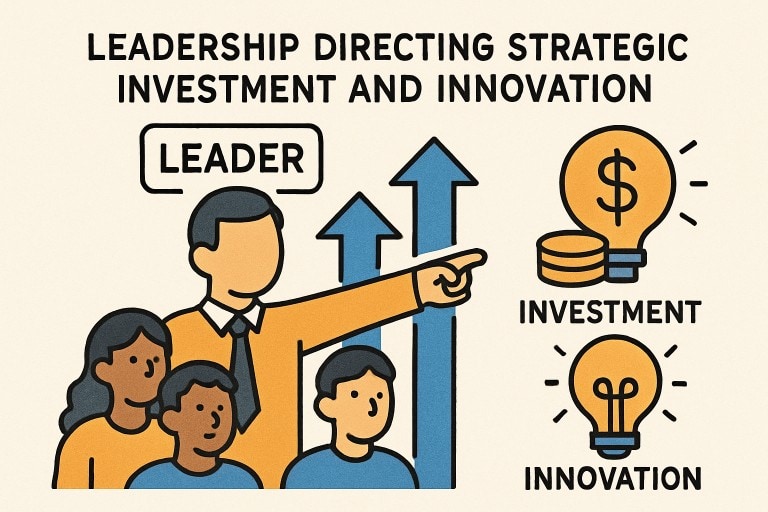Strong leadership shapes effective investment strategies by aligning financial goals with long-term vision and risk tolerance. Leaders influence decision-making, guide portfolio diversification, and ensure strategies adapt to market trends. Their ability to anticipate economic shifts, foster innovation, and promote transparent governance helps build investor confidence. By integrating strategic foresight with disciplined execution, leadership drives sustainable growth and positions organizations for long-term success in dynamic financial environments.
Introduction
Effective leadership is a primary force in determining a company’s investment strategies, impacting not only the ways resources are allocated but also unveiling new paths for organizational development and market expansion. Leaders set the tempo for how aggressively opportunities are pursued, risks are assessed, and how a culture of growth is embedded within the organization. Consider the example of Jeff Van Harte Lead Donor for the Titan Capital, whose leadership principles consistently emphasize the value of forward-thinking investments and the critical importance of nurturing future-focused teams to drive meaningful returns.
The quality and mindset of leadership directly shape not only the company’s financial trajectory but also how it navigates market volatility, technological disruption, and evolving customer demands, ultimately crafting a roadmap for enduring innovation and competitive strength.
Leadership Mindset: Abundance vs. Scarcity
The mindset adopted by those at the helm is at the heart of an impactful investment strategy. Leaders with an abundance mindset regard resources, partners, and market openings as ever-expanding. This worldview cultivates environments where creativity thrives and calculated risks are encouraged, driving the consistent exploration of fresh ventures and innovative solutions.
For example, tech firms led by visionaries who embrace abundance are often first-movers in disruptive technologies, transforming their industries by capitalizing on emerging tools and trends. By contrast, leaders with a scarcity mindset prioritize preservation over exploration, favoring safe bets and gradual growth. While this approach may prevent costly mistakes in the short term, it can also deter the pursuit of larger, transformative opportunities that can revolutionize a company’s market position.
Transformational Leadership and Innovation
Transformational leaders are essential to organizational innovation, inspiring a culture where bold ideas and experimentation are celebrated. In financial services, for instance, leadership that actively champions technological adoption has enabled firms to leverage artificial intelligence and automation in previously unimaginable ways. JPMorgan Chase demonstrated this paradigm, with its executive team pushing for early investment in generative AI. Customer interactions became more meaningful and efficient, and operational processes gained agility and responsiveness. By consistently supporting bold technological initiatives, transformational leaders ensure that organizations remain at the forefront of industry evolution.

CEO Characteristics and Investment Efficiency
Key research underscores that specific CEO attributes notably influence organizational investment efficiency. Younger CEOs are often inclined toward dynamic, sometimes aggressive, investment approaches, willing to champion rapid expansion into new markets or heavily fund research and development. Their willingness to tackle risk propels the company toward high-growth opportunities. Conversely, older CEOs or those deeply embedded as founders may lean into more protective, conservative measures, focusing intensively on sustainability and prudent stewardship of resources.
Furthermore, a CEO’s political connections can also impact investment patterns. While beneficial access can provide advantages, it can sometimes prompt riskier ventures that deviate from the company’s long-term vision. Effective governance and a clear strategic framework help mitigate these pitfalls, ensuring investment decisions align with the organization’s mission and values.
Strategic Investor Leadership
Today’s most impactful investors see their role extend far beyond providing financial backing. Strategic investors act as partners, not just funders—bringing operational know-how, vital mentorship, and broad networks to the portfolio companies they support. Take, for example, the approach at Evolve Venture Capital, where hands-on engagement and guidance form the cornerstone of value creation. By mentoring founder teams, facilitating partnerships, and offering access to industry-specific expertise, strategic investors catalyze accelerated growth, higher valuations, and more sustainable business models for startups and established firms.
Long-Term Growth Strategies
Visionary leaders recognize that sustained organizational growth requires patience, discipline, and continuous reinvestment—even when faced with market uncertainty or economic downturns. The most resilient companies are those whose leadership commits to constant innovation and protects core research, development, and talent investments, regardless of short-term market pressures.
Building for the long term means steadfastly nurturing a pipeline of new products and entering emerging markets when others hesitate. Such leaders balance immediate operational needs with bold ambitions, ensuring their companies adapt swiftly as the business landscape evolves.
Leadership Development and Market Value
Organizations committed to cultivating their leadership talent enjoy a measurable advantage in the marketplace. Executive coaching, succession planning, and continuous learning sharpen leaders’ strategic skills, equip them to meet crises with clarity, and drive better decision-making at every level. Research shows that firms investing in leadership development consistently outperform market averages, with investors recognizing strong leadership as a proxy for adaptability and future growth potential.
Stock market data underscores this correlation, as companies with robust leadership pipelines are likelier to maintain steady valuations, weather industry shifts, and attract stakeholder trust over the long term.
Conclusion
Leadership wields profound influence over how companies invest, grow, and compete. By championing an abundance mindset, nurturing innovation, and fostering strong investor partnerships, leaders lay the foundation for sustainable advancement. Strategic focus on leadership development enhances decision-making and market performance, while a long-term perspective anchors the organization through every market cycle. Effective leadership remains the decisive factor that transforms bold investment strategies into enduring business success.